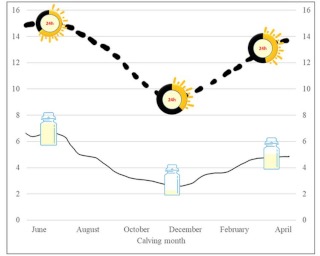By Victor Malacco
Colostrum yield seems to follow a seasonal pattern. Dairy farmers should alter their colostrum management programs and anticipate the low colostrum season.

Figure 1. Daytime length and colostrum production over a 12-month period.
Have you ever noticed that cows produce less colostrum during the fall and winter months? The deficiency in colostrum production is sometimes reported as no colostrum production at all. Despite the phenomenon observation, little is known about its causes.
Colostrum is essential for the newborn calf. Because the placenta of the cows completely separates the dam and fetal blood, no antibodies or immunoglobulins transfer occurs during gestation. Therefore, the newborn’s immune protection relies primarily on the colostrum immunoglobulins absorbed in the intestine during the first 24 hours after birth. In addition to antibodies, colostrum is a good source of several nutrients and bioactive compounds. It provides growth factors important to the developing calf, peptides with anti-microbial activity, and when fed fresh, can transfer immune cells to calves. The success of transferring the immunoglobulins to the calf depends on the timing that it will receive the colostrum and the colostrum quality, cleanness, and quantity. The quantity can be a challenge during the fall/winter months when the cows start to drop the colostrum synthesis.
It is well known that nutrition, dry period length, milk production history, and the number of calvings affect colostrum immunoglobulin concentration and its nutrient composition. However, the risk factors that result in low colostrum production remain unclear. A study by Gavin and colleagues conducted in a dairy herd in Texas evaluated the colostrum production and quality of 2,988 Jersey dairy cows during a year to assess possible effects of photoperiod, temperature, and cow factors on colostrum production. They observed an average colostrum production of 9.4 lbs. in a range of 0 to 58.4 lbs. Interestingly, they noted a considerable variation during the year, with average colostrum production of 14.5 lbs. in June, 5.5 lbs. in January, and 10.6 lbs. in May. They also observed that cows with more than one lactation had a more significant decline in colostrum production from June to December, on average, compared to first lactation heifers, with 35% of them producing no colostrum in December compared to 1% of the first lactation heifers. The primary factor identified by the authors affecting colostrum production was the photoperiod. They observed that longer sunlight duration 21 days before and at calving day strongly correlated with greater colostrum yield. They also highlighted that genetics could influence colostrum production, with the yield varying between sire lines within the Jersey breed.
Similarly, a study by Soufleri and colleagues conducted in Europe evaluating 1,017 healthy Holstein cows from 10 farms observed effects of the number of calvings, milk production in the previous lactation, and season of calving on colostrum yield with lower colostrum production observed in fall and winter months (13 lbs.) and greater on spring and summer (16 lbs.).
A more recent study led by Rossi and co-authors conducted at three commercial Michigan dairy farms observed the lowest colostrum yield during winter (4.5 quarts) by cows milked within 6 hours after calving when compared to the other seasons (5.7, 6.2, 5.7 quarts of colostrum during spring, summer, and fall, respectively). Interestingly, regardless of the season, only 40% of cows produced sufficient first milked colostrum to support the second meal of colostrum to calves (6 L total yield).
To date, the relationship between photoperiod and colostrum yield is an association, and a cause-effect relationship is yet to be determined. The speculation around the reduction in colostrum production and photoperiod length is related to the variation of hormones like melatonin and prolactin. The light incidence in the cows’ eyes controls melatonin secretion by the pineal gland, with long days resulting in low melatonin concentrations. On days with short photoperiod, melatonin concentrations are high, and could inhibit the release of the hormone prolactin and IGF-1. These hormones are essential for the induction and maintenance of lactation, and their lower concentrations could explain the low colostrum synthesis in cows exposed to reduced photoperiod. However, more studies are necessary to confirm this theory.
The reduction in colostrum yield seems to be a seasonal variation, with dry cow management and cow factors playing only a minor role in this phenomenon. Since providing extra daylight is not possible for many farms, the potential adverse effects of the colostrum shortage on calf health need to be addressed through well-planned banking of high-quality colostrum and the use of colostrum replacement strategies when necessary.
Another strategy already adopted for farms that have a low prevalence of failure of transfer of passive immunity and recommended by Michigan State University Extension is the second feeding of 2 to 3 quarts of colostrum 6 to 12 h after the first feeding. Calves that received a second colostrum feeding were less likely to develop morbidity, had better growth rates in the pre-weaning phase, and tended to produce more milk in the first lactation, as Rossi and colleagues reported.
Source : msu.edu